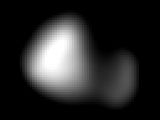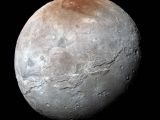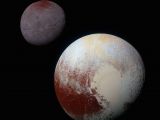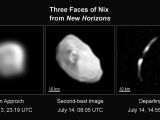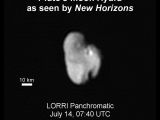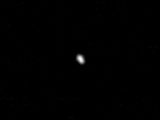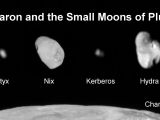Earlier this week, NASA's New Horizons probe, now exploring the outskirts of our Solar System, beamed back a view of Kerberos, one of the moons orbiting dwarf planet Pluto. The image, released by the space agency this past Thursday, October 22, is available in the gallery below.
Scientists at NASA say New Horizons obtained this view of Kerberos from a distance of about 245,600 miles (396,100 kilometers). The probe imaged the miniature satellite on July 14 of this year, just hours before making its closest approach to Pluto.
“This image of Kerberos was created by combining four individual Long Range Reconnaissance Imager (LORRI) pictures taken on July 14, approximately seven hours before New Horizons’ closest approach to Pluto,” reads the image's description.
Kerberos appears to comprise two lobes
Our Moon is an almost perfect sphere. Pluto's satellite Kerberos, however, looks more like an oversized cosmic potato, and not even an ideally shaped one for that matter.
The image delivered by NASA's New Horizons spacecraft just the other day hints that the celestial body comprises two lobes, of which one is estimated to measure around 5 miles (8 kilometers) across and the other 3 miles (5 kilometers).
Interestingly, mission scientists confess that, based on previous observations of the orb, they expected it to be a tad bigger than this. “Once again, the Pluto system has surprised us,” said New Horizons Project researcher Hal Weaver in a statement.
Then again, the research team also didn't expect Kerberos to have a highly-reflective surface. All the same, its brightness in this New Horizons image suggests that is does.
A complete portrait of the Pluto system
Dwarf planet Pluto is orbited by a total of 5 moons. Their names are Charon, Hydra, Nix, Kerberos and Styx, and they were only recently discovered.
Thus, while Pluto was first spotted by astronomer Clyde Tombaugh in February 1930, Charon was only documented in 1978. Then, Hydra and Nix were both discovered in 2005, and tiny Kerberos and Styx stayed hidden until 2011 and 2012, respectively.
The good news is that, thanks to NASA's New Horizons probe, we now know what each of these orbs at the edge of the Solar System looks like. Otherwise put, we now at long last have a complete portrait of the Pluto system.
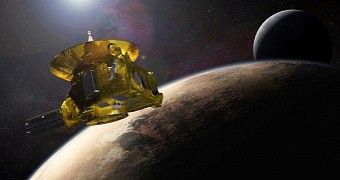
 14 DAY TRIAL //
14 DAY TRIAL // 
